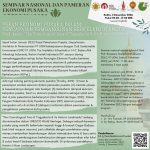Abstract
Recognizing that one of the most recent urban issues is the rapid change of cities in Europe and Asia. It is understood that changes as an impact of development in the built environment on whatever scales, from neighborhood units to the entire city, including heritage city, are, in fact, natural occurrences. Meanwhile, a historic city is not mainly about monuments and/or other tangible culture heritage. It is also a place to live which consists of various social and culture activities including intangible culture heritage and somehow the new life style within heritage place as well. Urban heritage conservation is, therefore, not just about the past. It is also not only a preservation of city’s historic fabrics nor beatification of city center, but more holistic approaches for natural, cultural-tangible and intangible heritage. The sense of utilization and continuity of history urban landscape becomes more important than ever.
Heritage conservation is actually a cultural movement. Management of continuity admits change is the central concept of conservation, a notion that differs from preservation. Consequently, this means that the changes which take place are not drastic in nature. The problem lies in how far those changes in the historic city can be called “natural”. The involvement of the residents is an essential aspect in resolving abovementioned urban conservation issues, and strengthening the platform for the future development of historic city. It is a duty for everyone in this century to maintain and pass along the urban heritage to the future generations. In the same time, it is a right to create, recreate, develop and contemplate the future heritage as well as managing urban heritage as a creative industry.
This paper highlights the ongoing efforts of urban conservation management in Indonesia in safeguarding the continuity of the urban heritage assets while in the same time prepare for various kinds of disaster risks, obtain a proper measurement of change in realizing the modern needs and a better quality of life. A brief review in building the strategic good governance on urban heritage management through Indonesian Heritage Cities Network (Jaringan Kota Pusaka Indonesia/JKPI), a mayors and regents of heritage cities/regencies network in Indonesia (2008) will be elaborated.
This paper also aims to propose a possible roles of the ASEM Culture Ministry Meeting to (1) provide a specific platform for the issue of good governance in managing historic cities, (2) promote the effectiveness of Heritage Impact Assessment as a procedure on the sustainable development in the historic cities, (3) formulate Manual for the Disaster Risk Management of Historic City, (4) develop several centers for capacity building through formal and informal education and training on urban heritage management for ASEM country members, and (5) elaborate the Culture360 in strengthening the networking on urban heritage management among people, academicians, NGOs, government officials, private sectors from Asian and European countries.
Keywords: Management of Continuity Admits Change, Historic Urban Landscape, JKPI, Good Governance, Capacity Building, Heritage Impact Assessment, Disaster Risk Management of Historic City
Author : Dr. Ir. Laretna T. Adishakti, M. Arch.
Managing Historic Cities: Management of Continuity Admits Change




